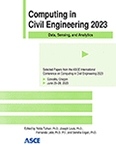Exploring Latency during Long-Distance Robot-Assisted Teleoperation and Construction
Publication: Computing in Civil Engineering 2023
ABSTRACT
NASA’s Artemis Program includes a plan to build a sustainable habitat on the lunar surface along with missions for Mars exploration. With the advanced technology in teleoperation, such tasks outside of the Earth have become feasible. To conduct the surveying, excavation, and site preparation toward the habitat construction in the future, we should prepare against many challenging and uncertain issues, such as microgravity, regolith dust, and extreme environments. Under those inherent environmental constraints, a robust teleoperation system plays a key role in mission tasks on the lunar surface. In a remote-control system, a time delay occurs inevitably in data processing or signal transmission. This latency affects operators’ mental workload, situational awareness, decision-making, and in turn, work performance. Therefore, there is a need to better understand uncertainties due to latency in advance to reduce unexpected or uncontrolled situations. This paper examines the impacts of time delay during space teleoperation and discusses future research directions. The capabilities of teleoperation for knowledge-based work under latency conditions are evaluated based on the technical limitations and requirements. The outcome of this paper is expected to provide foundational knowledge to minimize operators’ mental workload and improve work performance in long-distance robot-assisted teleoperation.
Get full access to this article
View all available purchase options and get full access to this chapter.
REFERENCES
Bidwell, J., Holloway, A., and Davidoff, S. (2014). Measuring operator anticipatory inputs in response to time-delay for teleoperated human-robot interfaces. Proceedings of the SIGCHI Conference on Human Factors in Computing Systems, 1467–1470. https://doi.org/10.1145/2556288.2557174.
Bualat, M., et al. (2013, September 10). Surface Telerobotics: Development and Testing of a Crew Controlled Planetary Rover System. AIAA SPACE 2013 Conference and Exposition. AIAA SPACE 2013 Conference and Exposition, San Diego, CA. https://doi.org/10.2514/6.2013-5475.
Chen, J. Y. C., Haas, E. C., Pillalamarri, K., and Jacobson, C. N. (2006). Human-Robot Interface: Issues in Operator Performance, Interface Design, and Technologies. Army Research Laboratory, 100.
Coloma, S., Martinez, C., Yalçın, B. C., and Olivares-Mendez, M. A. (2022). Enhancing Rover Teleoperation on the Moon With Proprioceptive Sensors and Machine Learning Techniques. IEEE Robotics and Automation Letters, 7(4), 11434–11441. https://doi.org/10.1109/LRA.2022.3198794.
Farajiparvar, P., Ying, H., and Pandya, A. (2020). A Brief Survey of Telerobotic Time Delay Mitigation. Frontiers in Robotics and AI, 7, 578805. https://doi.org/10.3389/frobt.2020.578805.
Grande, M. L., Moses, R. W., Cosgrove, P. A., Mueller, R. P., Prater, T. J., and Blanchard, A. J. (2021, November 15). Protecting Crew and Surface Systems with a Long-Duration Lunar Safe Haven. ASCEND 2021. ASCEND 2021, Las Vegas, Nevada & Virtual. https://doi.org/10.2514/6.2021-4070.
Guo, Y., Freer, D., Deligianni, F., and Yang, G.-Z. (2022). Eye-Tracking for Performance Evaluation and Workload Estimation in Space Telerobotic Training. IEEE Transactions on Human-Machine Systems, 52(1), 1–11. https://doi.org/10.1109/THMS.2021.3107519.
Guo, Z., Zhang, S., Wang, Y., and Nian, D. (2016). Design of data communication system for space manipulator teleoperation. 2016 IEEE 11th Conference on Industrial Electronics and Applications (ICIEA), 1169–1174. https://doi.org/10.1109/ICIEA.2016.7603761.
Jud, D., Kerscher, S., Wermelinger, M., Jelavic, E., Egli, P., Leemann, P., Hottiger, G., and Hutter, M. (2021). HEAP - The autonomous walking excavator. Automation in Construction, 129, 103783. https://doi.org/10.1016/j.autcon.2021.103783.
Kim, E., Peysakhovich, V., and Roy, R. N. (2021). Impact of communication delay and temporal sensitivity on perceived workload and teleoperation performance. ACM Symposium on Applied Perception 2021, 1–8. https://doi.org/10.1145/3474451.3476233.
McHenry, N., Spencer, J., Zhong, P., Cox, J., Amiscaray, M., Wong, K. C., and Chamitoff, G. (2021). Predictive XR Telepresence for Robotic Operations in Space. 2021 IEEE Aerospace Conference (50100), 1–10. https://doi.org/10.1109/AERO50100.2021.9438161.
Schmidt, G. R., Landis, G. A., and Oleson, S. R. (2012). Human Exploration using Real-Time Robotic Operations (HERRO): A space exploration strategy for the 21st century. Acta Astronautica, 80, 105–113. https://doi.org/10.1016/j.actaastro.2012.05.036.
Sena, A., Rouxel, Q., Ivanova, E., Burdet, E., and Li, Z. (2021). Haptic Bimanual System for Teleoperation of Time-Delayed Tasks. 2021 IEEE International Conference on Robotics and Biomimetics (ROBIO), 1234–1239. https://doi.org/10.1109/ROBIO54168.2021.9739628.
Sheridan, T. B. (1993). Space teleoperation through time delay: Review and prognosis. IEEE Transactions on Robotics and Automation, 9(5), 592–606. https://doi.org/10.1109/70.258052.
Weber, B., Balachandran, R., Riecke, C., Stulp, F., and Stelzer, M. (2019). Teleoperating Robots from the International Space Station: Microgravity Effects on Performance with Force Feedback. 2019 IEEE/RSJ International Conference on Intelligent Robots and Systems (IROS), 8144–8150. https://doi.org/10.1109/IROS40897.2019.8968030.
Wilde, M., Harder, J. T., Ventura, J., Hörmann, J., and Walter, U. (2015). Impact of Space-to-Ground Video Transmission Constraints on Teleoperated Final Approach and Docking. Journal of Aerospace Information Systems, 12(7), 441–454. https://doi.org/10.2514/1.I010288.
Wojtusch, J., Taubert, D., Graber, T., and Nergaard, K. (2018). Evaluation of Human Factors for Assessing Human-Robot Interaction in Delayed Teleoperation. 2018 IEEE International Conference on Systems, Man, and Cybernetics (SMC), 3787–3792. https://doi.org/10.1109/SMC.2018.00641.
Zhang, Y., and Li, H. (2016). Handling qualities evaluation of predictive display model for rendezvous and docking in lunar orbit with large time delay. 2016 IEEE Chinese Guidance, Navigation and Control Conference (CGNCC), 742–747. https://doi.org/10.1109/CGNCC.2016.7828878.
Zhou, J., Zhou, J., and Jiang, Z. (2014). Design and Validation of Novel Teleoperation Rendezvous and Docking System. Journal of Aerospace Engineering, 27(5). https://doi.org/10.1061/(ASCE)AS.1943-5525.0000264.
Information & Authors
Information
Published In
History
Published online: Jan 25, 2024
ASCE Technical Topics:
- Aerospace engineering
- Automation and robotics
- Business management
- Construction engineering
- Construction management
- Construction sites
- Engineering fundamentals
- Geomatic surveys
- Geomatics
- Practice and Profession
- Site surveys
- Space colonies
- Space construction
- Space exploration
- Sustainable development
- Systems engineering
Authors
Metrics & Citations
Metrics
Citations
Download citation
If you have the appropriate software installed, you can download article citation data to the citation manager of your choice. Simply select your manager software from the list below and click Download.
